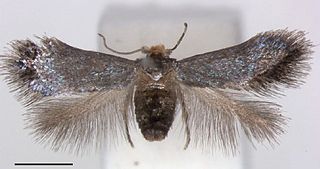
Nepticulidae is a family of very small moths with a worldwide distribution. They are characterised by eyecaps over the eyes. These pigmy moths or midget moths, as they are commonly known, include the smallest of all living moths, with a wingspan that can be as little as 3 mm in the case of the European pigmy sorrel moth, but more usually 3.5–10 mm. The wings of adult moths are narrow and lanceolate, sometimes with metallic markings, and with the venation very simplified compared to most other moths.
Andesiana is a genus representing its own family Andesianidae and superfamily Andesianoidea, the "Andean endemic moths". It contains three species with a wingspan up to 5.4 cm. in female A. similis and 3.5 cm. in males. This far surpasses in size any previously known monotrysian moth. These large Microlepidoptera are restricted to Andean South America, from where they were described originally in 1989 in the family Cossidae by their discoverer Patricia Gentili.
Roscidotoga is a genus of moths of the family Nepticulidae.
Ectoedemia hadronycha is a moth of the family Nepticulidae and belongs to the Fomoria subgenus of Ectoedemia. It is endemic to Australia, where it is found along the north-eastern coast of Queensland.
Ectoedemia squamibunda is a moth of the family Nepticulidae. It is found along the north-eastern coast of Queensland, Australia.
Roscidotoga eucryphiae is a moth of the family Nepticulidae. It is found in Tasmania.
Roscidotoga sapphiripes is a moth of the family Nepticulidae. It is found along the north-eastern coast of Queensland.
Pectinivalva caenodora is a moth of the family Nepticulidae. It is found along the south-eastern coast of New South Wales.
Pectinivalva gilva is a moth of the family Nepticulidae. It is found along the south-eastern coast of New South Wales.
Pectinivalva melanotis is a moth of the family Nepticulidae. It is found along the south-eastern coast of New South Wales.
Pectinivalva anazona is a moth of the family Nepticulidae. It is found along the south-eastern coast of New South Wales.
Pectinivalva funeralis is a moth of the family Nepticulidae. It is found along the southeastern coast of New South Wales.
Pectinivalva libera is a moth of the family Nepticulidae. It is found along the southeastern coast of New South Wales.
Pectinivalva planetis is a moth of the family Nepticulidae. It is found along the southeastern coast of New South Wales.
Pectinivalva primigena is a moth of the family Nepticulidae. It is found along the south-eastern coast of New South Wales, Australia.

Pectinivalva minotaurus is a moth of the family Nepticulidae. It is found in southern Queensland.

Pectinivalva scotodes is a moth of the family Nepticulidae. It is found in New South Wales and southern Queensland.

Pectinivalva quintiniae is a moth of the family Nepticulidae. It is found in northern New South Wales and southern Queensland.

Pectinivalva tribulatrix is a moth of the family Nepticulidae. It is found in northern Queensland.
Roscidotoga lamingtonia is a moth of the family Nepticulidae. It is found in southern Queensland and northern New South Wales.




